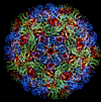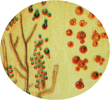| Growth of Prokaryotes |  |
| Readings | Presentations | Key Terms | Questions | Multiple Choice Quizzes | Updated 13/02/01 |
![]()
"Predigested
food" should be inscribed over every hall of learning as a
warning to all
who do not wish to lose their own personalities and their
original sense of judgement
Emma Goldman
Who Am I? As an endocrinologist I developed the technique of radioimmunoassay for which I received the Noble prize in medicine in 1977
| Readings Growth of Prokaryotes | |||
 |
Baron
Medical Microbiology Chap 4: Bacterial Metabolism |
 |
Brock
9th Ed Biology of Microorganisms Chap 5 Microbial Growth |
| Tortora:
Microbiology An Introduction Chapter 6 Growth of Prokaryotes |
 |
Jacquelyn
Black 4th Ed Microbiology: Principles & Explorations Chap 6 Growth and Culturing of Bacteria |
|
| Presentation | Slides | Web Animation | Download |
| Nutrients | |||
| Growth | |||
| Cell Counts | |||
| KEY TERMS | |||
| Psychrophile | psychrotroph | extreme halophiles | superoxide free radicals |
| Mesophile | hyperthermophiles | halophiles | superoxide dimutase |
| Thermophile | extreme thermophiles | obligate halophiles | catalase |
| minimum growth temperature | acidophiles | facultative halophiles | peroxide ion |
| optimum growth temperature | plasmolysis | nitrogen fixation | peroxidase |
| maximum growth temperature | obligate aerobes | trace elementes | organic growth factors |
| obligate anaerobes | facultative anaerobes | aerototlerant anerobes | microaerophiles |
| culture medium | sterile | agar | turbidity |
| chemically defined media | complex media | selective media | differential media |
| enrichment media | colony | streak plate method | binary fission |
| budding | generation time | lag phase | log phase |
| exponential growth | stationary phase | death phase | plate counts |
| serial dilution | pour plates | spread plates | |
![]()
- List the chemical requirements for microbial growth
- List the physical requirements for microbial growth
- Classify microbes into five groups on the basis of preferred temperature range
- Explain the importance of osmotic pressure to microbial growth
- Identify why the pH of culture media is controlled
- Identify how the pH of culture media is controlled
- Describe how pure cultures can be isolated using the dilution plate method
- Describe bacterial growth, including binary fission
- Describe the four steps in binary fission
- Describe four direct methods of measuring cell growth
- Describe how to enumerate bacteria by the serial dilution method
- Describe the structure and use of a Petroff-Hausser cell counter
- Compare the phases of microbial growth and describe their relation to generation time
- Describe how to enumerate bacteria by filtration
- Describe how to enumerate bacteria by the most probable number method
- Differentiate between direct and indirect methods of measuring cell growth
- Explain three indirect methods of measuring cell growth
- A pastry chef accidently inoculated a cream donut with six cells of Staphylococcus aureus. If Staphylococcus aureus has a generation time of 60 minutes, how many cells would be in the cream pie after 7 hours (Note the generation time and the incubation time could be modfyied on the actual exam question so learn the principle rather than just memorizing the answer)
- Why can high concentrations of salt or sugar be used to preserve food
- Draw a typical bacterial growth curve, label and define each of the four phases
- Draw the following growth curves for E. coli, a mesophile, starting with 100 cells with a generation time of 30 min at 35 C. This question can be modified to use a pycrohiles, a psycrotroph a thermophile or a thermotroph and the temperatures and incubation periods can be also changed. Learn the principle not just the answers
- the cells are imcubated for 5 hours at 35 C
- after 5 hoursat 35 C, the temperature is changed to 20 C for 2 hours
- alternatively, after 5 hours at 35 C, the temperature is changed to 5C for 2 hours followed by 35 C for 5 hours